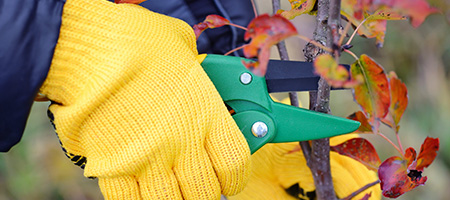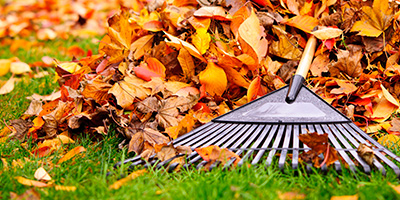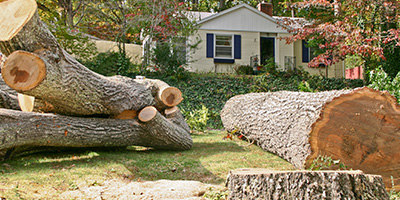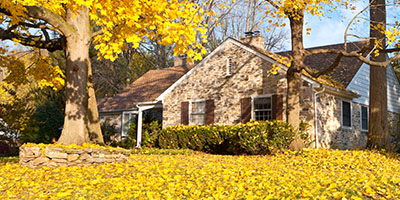Ways to Dispose of Leaves This Fall

What to Do With Leaves in the Fall
Leaves are falling all around, it’s time I pick up my rake…
OK, so maybe those aren’t the lyrics to “Ramble On.” But during fall, you’re likely looking for some ideas on how to get rid of leaves scattered across your yard. Whether you plan to get them out of sight or make use of them, read on for some leaf disposal ideas.
What Happens if I Don’t Rake My Leaves?
Well, that depends. If the leaves are covering less than 10% of your yard, you’re better off letting them be. As they break down, leaves release nutrients that can benefit your lawn and garden beds. In fact, leaves from certain trees, like maple and oak, reduce the likelihood of weeds germinating. Your best bet is to mulch the leaves with your mower and let the pieces settle into your lawn.
On the other hand, if you have a thick bed of leaves covering your yard, leaving them alone can be bad for a few reasons. Too much leaf coverage can smother your grass. And if you don’t deal with it quickly in the spring, it will inhibit grass growth.
How to Get Rid of Your Leaves
There are a few ways to dispose of your leaves. Hiring a pro is one option. On average, professional leaf removal cost is about $360, reports Home Advisor. Prices can range from $190 to more than $600, depending on the size of your property, how you dispose of the leaves and where you live.
You can also save money going it alone. Then the costs boil down to buying any leaf clean up tools you don’t already have, and renting a dumpster if leaf disposal is part of a larger fall yard cleanup project. Consider renting your tools when applicable.
Rake
A rake is the standard yard tool for getting rid of leaves. It will also grab any loose twigs and grass clippings in your yard. You might spend $20 to $30 for a good one, but you can find some for less than that. We recommend buying one with an ergonomically shaped handle so you don’t strain your back. Make sure you get one with a wide end to maximize how many leaves you’ll move with each stroke. About 30 inches wide should do it.
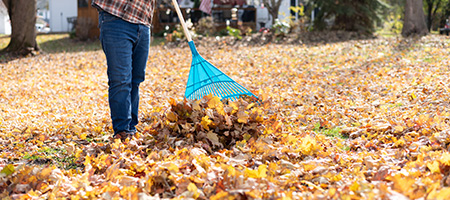
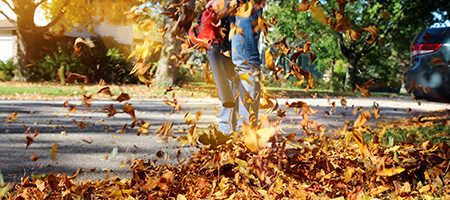
Leaf Blower
To save your back and arms some strain, you could always go with a leaf blower — though we recommend wearing ear protection, as noise from leaf blowers can lead to hearing damage.
Leaf blowers can range from as low as $17 to more than $600. Prices depend on how it’s powered and its performance. On average, gas-powered blowers are more expensive, while corded blowers are the least expensive option. Performance-wise, gas models are more powerful but are heavier, noisier and create emissions that can harm the user and the environment.
We recommend renting a 36V battery-powered handheld blower. It will cost you about $21 per day, typically isn’t as loud as its gas-powered counterparts and is a powerful way to dispose of leaves quickly. If you’re looking to buy, consider an electric blower with a mulcher option. That way you can chop up the leaves and put them to work in your yard.

Pro Tip: Check with your local municipality for leaf blower regulations. Some restrict leaf blower usage to specific time windows, if they’re allowed at all.
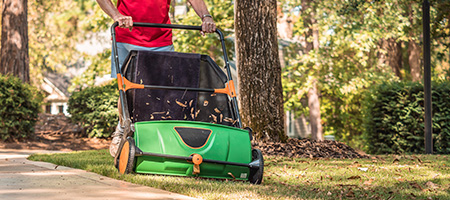
Lawn Sweeper
Lawn sweepers are an easy way to dispose of leaves. They use cylindrical brushes to lift leaves, grass clippings and other debris into a hopper as you go. Expect to spend about $200 for a push lawn sweeper. If you’re attaching one to the back of your tractor, that can run you $400 to $500. That compares to a rental, which could run you less than $100 a day for a pull-behind.
Once you have the leaves gathered up in the hopper, easily transfer them to a bag or burn pile.
Lawn Mower
If you have a lawn mower with a bag, this is a great way to pick up leaves fast. Mowers also mulch leaves and collect them for use in your yard or garden beds. You’ll also fit more debris in each bag if you chop it up first. A self-propelled mower with mulcher and bag costs $200 to $600, or $50 a day to rent.
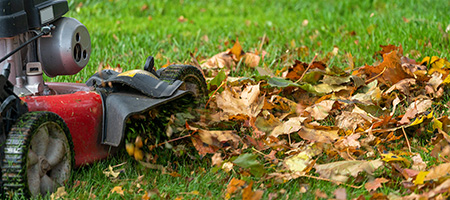
Lose the Bag, Use the Mulch
Unless you have a thick layer of leaves that threatens to smother your grass, take the catcher bag off your mower and put those mulched leaves to work. Mow over the leaves until the pieces are the size of a dime and you can see about a half-inch of grass through the mulch layer. As the pieces settle, worms and microorganisms will do their thing to decompose the mulch, feeding lots of healthy nutrients into your lawn.
Ways to Dispose of Leaves Yourself
Any thoughts on what to do with your leaves now that you’ve gathered them into tidy piles? Here are some ideas on how to dispose of leaves.
Bag Them
Bagging is one of the most common leaf disposal ideas. You can handle the whole project with a rake and some lawn bags, so it keeps leaf removal costs low. We recommend using recyclable paper bags you can find at big box hardware stores, or large lawn bags. Check with your local municipality on pickup schedules and any related restrictions. If you’re going all out on a large-scale yard cleanup, toss your bagged leaves in a dumpster rental with the rest of your yard waste.
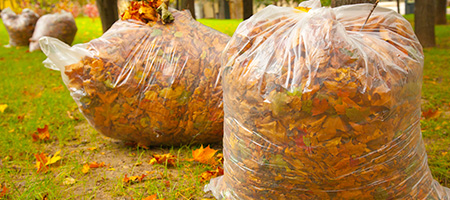
Tips for Bagging Your Leaves
- Work on a dry, calm day. If possible, wait for a day with little to no wind and when the leaves are dry. Strong winds will blow your leaves all over the place, making for a counterproductive afternoon. If the leaves are too wet, they can be tough to move with a rake or leaf blower.
- Dress for the occassion. You’ll be kicking up dust and other allergens while you work. Be sure to wear a hat, long-sleeve shirt and pants. It’s also a good idea to wear gloves to prevent blisters. If you’re using a leaf blower, eye and ear protection are a must.
- Work in one direction, downhill. If your yard has a slope, let gravity be your friend. Work downhill to make it easy on yourself. Keep moving in one direction to ensure you’re not raking or blowing leaves in spots you’ve already cleared.
- Move your leaves onto a tarp. This beats stopping every so often to pick leaves up and shove them into a bag or wheelbarrow. Plus, it will save some strain on your back. Once you’ve collected your leaves on the tarp, you can drag them to your dumpster. Or, work with a partner to lift the tarp and use it like a funnel to fill your bags.
- Don't stress your body. Use best practices for your leaf clean up tools. If you’re using a rake, pull the leaves toward you. Keep your back straight and abs tight, avoiding any twists and turns. Switch your hand positions frequently to keep your arms and shoulders from wearing out. For leaf blowers, hold the blower at your side and use a smooth back-and-forth motion.
- Take Breaks. Don’t hesitate to stop for a minute to grab a snack and a drink of water. Before you break, stomp on your leaf pile. This will pack them down so they don’t blow all over the yard while you recuperate.
Burn Them
Burning is a simple, low-cost way to dispose of leaves and other yard waste. Always check local regulations before burning. If it’s legal to do so, follow proper guidelines on how to burn leaves safely. Keep your fire contained in a pit that’s at least 150 feet away from your neighbors and 50 feet from your own home. Choose a calm, windless day and make sure the leaves are dry before you burn.
Mulch Leaves for Your Garden Beds
Not a fan of leaf disposal ideas like bagging and burning? Consider putting them to good use in your garden. Leave the catch bag on your mower and set the blade to 2.5” to 4” high. Run the mower over the leaves until they’re all nicely chopped. Make sure the leaves are dry, as mowing anything wet can damage your mower.
After you’ve winterized your garden, consider adding a layer of mulched leaves to your beds to protect tender plants from the cold winter months. Cover cold-weather vegetables like kale, spinach and beets, and you can harvest them all winter. Or just mix some of the chopped leaves into your garden for some great soil next spring.
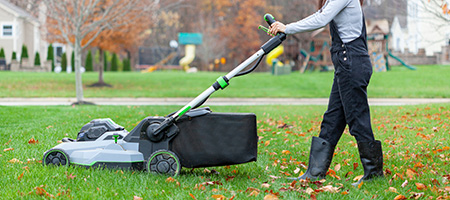
Use the Mulch for a Lasagna Garden
If you bag your mulched leaves, make a lasagna garden. Layer your leaves with other compostable materials — newspaper, cardboard, grass clippings. The worms and microorganisms will decompose everything, turning it into a rich, nutrient-dense soil. Start the process in the fall for an efficient and eco-friendly alternative to filling your garden bed with fresh soil in the spring.
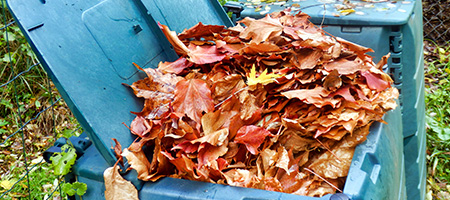
Compost Leaves for Next Year
Get rid of your leaves and make a nutrient-rich compost for next year’s plants. Add shredded leaves to your compost bin or pile them in a corner of your yard. Top the leaf pile with nitrogen-rich organic material like grass clippings, food waste or manure. Turn the compost once monthly until it’s dark, dry and crumbly, and smells earthy.
Make a Leaf Mold
A leaf mold does a great job retaining moisture in the soil of your garden bed. It’s also a good solution for controlling weeds. Place the shredded leaves in a large garbage bag and water them until damp. Seal the bag tight and cut a few slits to let air flow through. Shake the bag every few weeks. After about six months, the leaf mold should be brown or black and crumbly and ready for spring.
